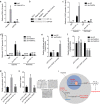Long non-coding RNA PAARH promotes hepatocellular carcinoma progression and angiogenesis via upregulating HOTTIP and activating HIF-1α/VEGF signaling
- PMID: 35110549
- PMCID: PMC8810756
- DOI: 10.1038/s41419-022-04505-5
Long non-coding RNA PAARH promotes hepatocellular carcinoma progression and angiogenesis via upregulating HOTTIP and activating HIF-1α/VEGF signaling
Abstract
Hepatocellular carcinoma (HCC) is one of the leading lethal malignancies and a hypervascular tumor. Although some long non-coding RNAs (lncRNAs) have been revealed to be involved in HCC. The contributions of lncRNAs to HCC progression and angiogenesis are still largely unknown. In this study, we identified a HCC-related lncRNA, CMB9-22P13.1, which was highly expressed and correlated with advanced stage, vascular invasion, and poor survival in HCC. We named this lncRNA Progression and Angiogenesis Associated RNA in HCC (PAARH). Gain- and loss-of function assays revealed that PAARH facilitated HCC cellular growth, migration, and invasion, repressed HCC cellular apoptosis, and promoted HCC tumor growth and angiogenesis in vivo. PAARH functioned as a competing endogenous RNA to upregulate HOTTIP via sponging miR-6760-5p, miR-6512-3p, miR-1298-5p, miR-6720-5p, miR-4516, and miR-6782-5p. The expression of PAARH was significantly positively associated with HOTTIP in HCC tissues. Functional rescue assays verified that HOTTIP was a critical mediator of the roles of PAARH in modulating HCC cellular growth, apoptosis, migration, and invasion. Furthermore, PAARH was found to physically bind hypoxia inducible factor-1 subunit alpha (HIF-1α), facilitate the recruitment of HIF-1α to VEGF promoter, and activate VEGF expression under hypoxia, which was responsible for the roles of PAARH in promoting angiogenesis. The expression of PAARH was positively associated with VEGF expression and microvessel density in HCC tissues. In conclusion, these findings demonstrated that PAARH promoted HCC progression and angiogenesis via upregulating HOTTIP and activating HIF-1α/VEGF signaling. PAARH represents a potential prognostic biomarker and therapeutic target for HCC.
© 2022. The Author(s).
Conflict of interest statement
The authors declare no competing interests.
Figures








Similar articles
-
Long non-coding RNA MAPKAPK5-AS1/PLAGL2/HIF-1α signaling loop promotes hepatocellular carcinoma progression.J Exp Clin Cancer Res. 2021 Feb 17;40(1):72. doi: 10.1186/s13046-021-01868-z. J Exp Clin Cancer Res. 2021. PMID: 33596983 Free PMC article.
-
F13B regulates angiogenesis and tumor progression in hepatocellular carcinoma via the HIF-1α/VEGF pathway.Biomol Biomed. 2024 Dec 11;25(1):189-209. doi: 10.17305/bb.2024.10794. Biomol Biomed. 2024. PMID: 39319846 Free PMC article.
-
Silencing of long noncoding RNA LEF1-AS1 prevents the progression of hepatocellular carcinoma via the crosstalk with microRNA-136-5p/WNK1.J Cell Physiol. 2020 Oct;235(10):6548-6562. doi: 10.1002/jcp.29503. Epub 2020 Feb 18. J Cell Physiol. 2020. PMID: 32068261
-
The role of noncoding RNAs in the tumor microenvironment of hepatocellular carcinoma.Acta Biochim Biophys Sin (Shanghai). 2023 Nov 25;55(11):1697-1706. doi: 10.3724/abbs.2023231. Acta Biochim Biophys Sin (Shanghai). 2023. PMID: 37867435 Free PMC article. Review.
-
LncRNA SNHG1: A novel biomarker and therapeutic target in hepatocellular carcinoma.Gene. 2025 Jul 20;958:149462. doi: 10.1016/j.gene.2025.149462. Epub 2025 Apr 3. Gene. 2025. PMID: 40187618 Review.
Cited by
-
Prognostic Signature Constructed of Seven Ferroptosis-Related lncRNAs Predicts the Prognosis of HBV-Related HCC.J Gastrointest Cancer. 2024 Mar;55(1):444-456. doi: 10.1007/s12029-023-00977-6. Epub 2023 Nov 25. J Gastrointest Cancer. 2024. PMID: 38006465
-
Identification of survival related key genes and long-term survival specific differentially expressed genes related key miRNA network of primary glioblastoma.Heliyon. 2024 Mar 26;10(7):e28439. doi: 10.1016/j.heliyon.2024.e28439. eCollection 2024 Apr 15. Heliyon. 2024. PMID: 38601561 Free PMC article.
-
LncRNAs Are Key Regulators of Transcription Factor-Mediated Endothelial Stress Responses.Int J Mol Sci. 2024 Sep 8;25(17):9726. doi: 10.3390/ijms25179726. Int J Mol Sci. 2024. PMID: 39273673 Free PMC article. Review.
-
LINC01305 recruits basonuclin 1 to act on G-protein pathway suppressor 1 to promote esophageal squamous cell carcinoma.Cancer Sci. 2023 Nov;114(11):4314-4328. doi: 10.1111/cas.15963. Epub 2023 Sep 13. Cancer Sci. 2023. PMID: 37705202 Free PMC article.
-
HLA-DQB1-AS1 Promotes Cell Proliferation, Inhibits Apoptosis, and Binds with ZRANB2 Protein in Hepatocellular Carcinoma.J Oncol. 2022 May 11;2022:7130634. doi: 10.1155/2022/7130634. eCollection 2022. J Oncol. 2022. PMID: 35602293 Free PMC article.
References
-
- Sung H, Ferlay J, Siegel RL, Laversanne M, Soerjomataram I, Jemal A, et al. Global Cancer Statistics 2020: GLOBOCAN Estimates of Incidence and Mortality Worldwide for 36 Cancers in 185 Countries. CA Cancer J Clin. 2021;71:209–49. - PubMed
-
- Villanueva A. Hepatocellular Carcinoma. N Engl J Med. 2019;380:1450–62. - PubMed
Publication types
MeSH terms
Substances
LinkOut - more resources
Full Text Sources
Medical

